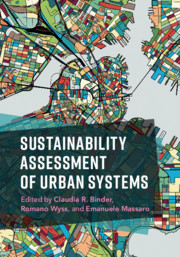Book contents
- Sustainability Assessment of Urban Systems
- Sustainability Assessment of Urban Systems
- Copyright page
- Contents
- Preface
- Acknowledgments
- Contributors
- General Introduction
- Part I Theoretical Background
- Part II Integrative Approaches for Sustainability Assessment
- Part III Perspectives on Urban Sustainability
- Part IV Focal Points of Urban Sustainability
- 15 Energy Challenges in Urban Systems
- 16 Sustainability Assessment of the Housing System: Exploring the Interplay between the Material and Social Systems
- 17 Sustainability Assessment of Urban Agriculture
- 18 Cities and Entropy: Assessing Urban Sustainability as a Problem of Coordination
- 19 Conceptualizing Urban Systems for Ecologic Sustainability Assessments: Case Study of the Stockholm Royal Seaport City District
- 20 A Study of Ride-Sharing Opportunities in the City of Santiago de Chile
- 21 Mosquito-Borne Disease and Human Mobility in Urban Environments
- Index
- References
19 - Conceptualizing Urban Systems for Ecologic Sustainability Assessments: Case Study of the Stockholm Royal Seaport City District
from Part IV - Focal Points of Urban Sustainability
Published online by Cambridge University Press: 27 March 2020
- Sustainability Assessment of Urban Systems
- Sustainability Assessment of Urban Systems
- Copyright page
- Contents
- Preface
- Acknowledgments
- Contributors
- General Introduction
- Part I Theoretical Background
- Part II Integrative Approaches for Sustainability Assessment
- Part III Perspectives on Urban Sustainability
- Part IV Focal Points of Urban Sustainability
- 15 Energy Challenges in Urban Systems
- 16 Sustainability Assessment of the Housing System: Exploring the Interplay between the Material and Social Systems
- 17 Sustainability Assessment of Urban Agriculture
- 18 Cities and Entropy: Assessing Urban Sustainability as a Problem of Coordination
- 19 Conceptualizing Urban Systems for Ecologic Sustainability Assessments: Case Study of the Stockholm Royal Seaport City District
- 20 A Study of Ride-Sharing Opportunities in the City of Santiago de Chile
- 21 Mosquito-Borne Disease and Human Mobility in Urban Environments
- Index
- References
Summary
Ecologic sustainability assessments are of increasing importance in understanding the physical resource metabolism of urban systems. In Stockholm, the so-called Hammarby Model visualised important synergies in waste and energy flows in the Hammarby Sjöstad urban district and supported improved metabolic thinking. Following the success of this approach, the Eco-Cycle Model 2.0 for the Royal Seaport was developed in cooperation between KTH University and the City of Stockholm. The Eco-Cycle Model 2.0 can take account of more dimensions than the Hammarby Model, including overall and detailed descriptions of resource flows in a lifecycle perspective. Important starting points for the model were (1) global and local challenges concerning the use of resources, with specific relevance for urban development, (2) available models which visualise functions, resource flows, and resource synergies and (3) approaches to material, energy, and water accounting. The primary objective of the model is to show important connections and synergies between resource flows in a modern urban area. Secondary objectives that can be fulfilled in the long term are: to be a tool for the monitoring and follow-up of environmental objectives, to serve as a dynamic tool for the analysis of resource flows, and to contribute to improved urban planning.
Keywords
- Type
- Chapter
- Information
- Sustainability Assessment of Urban Systems , pp. 460 - 479Publisher: Cambridge University PressPrint publication year: 2020

